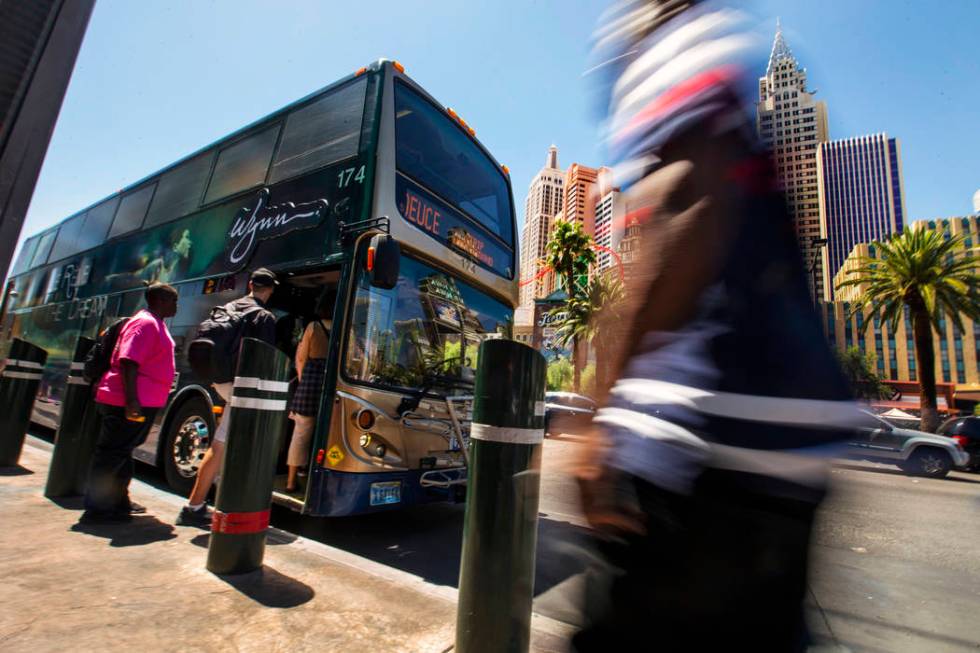RTC fights ‘Uber effect’ as bus revenue drops on Las Vegas Strip

The way residents and visitors get around could undergo growing pains as the Las Vegas Valley continues to grow.
The main public mass transit option in the area has long been the Regional Transportation Commission of Southern Nevada buses. But the system is being threatened by the continued surge in popularity of ride-hailing companies like Uber and Lyft.
In the general market — anything outside of the resort corridor — RTC bus ridership climbed 3.3 percent between fiscal 2018 and 2019. However, system-wide revenue was still down over that time frame due to a 6.7 percent dip in ridership on the Strip.
Over the past five years, Las Vegas Boulevard bus revenue has declined 29 percent, or $7 million, as companies like Uber and Lyft have taken the shine off the RTC’s “golden egg,” according to RTC CEO Tina Quigley.
App-based ride-hailing services are lowering ridership of not only the bus system but also the taxicab industry and even the Las Vegas Monorail.
And the trend is not limited to Las Vegas; just about every city with a sizable population is seeing the “Uber effect.”
Looking to combat the revenue loss, the RTC launched its own pilot ride-hailing program, Trip to Strip, in May. The program includes app-based ride hailing from McCarran International Airport and the resort corridor in 11-seat vans with luxury seating.
In the first 14 weeks of operations, the service has seen 18,000 riders from 5,600 trips, generating $74,000 in revenue, according to the RTC.
Gregory Erhardt, assistant professor of civil engineering at the University of Kentucky, who helped author a study on the effect of ride-hailing companies on public transit, said those efforts are unlikely to make a sizable dent in Uber’s and Lyft’s saturation of the market.
“A Canadian town, Innisfil, (Ontario), tried this,” Erhardt said. “The main finding is that the experiment was not scalable.”
Although public transportation is being tested by emerging technologies, it will still play an important role in the years to come for multiple reasons, Erhardt said.
“It promotes equity, providing transportation for people who cannot afford to pay extra for ride hailing, as well as persons with disabilities,” he said. “Transit is more space-efficient, which is particularly important in crowded downtown areas. If you take people off the bus and put them in a car, it slows down traffic for everyone, including the people left behind on the bus.”
One possible emerging transportation option, Elon Musk’s Boring Co. model of tunnel-based, underground people movers, won’t be a huge hit to public mass transit, Erhardt predicted. Elon Musk’s Boring Co. tunnel-based system will be used in its first commercial form at the Las Vegas Convention Center.
With space being an issue for all forms of transportation, that concept too is constrained, despite being underground.
“If you dig a tunnel wide enough to fit a car, you can fit one car through at a time and will rapidly run into capacity constraints once you account for the need to get in and out of the tunnel,” he said. “One solution to the capacity problem is to run buses or trains through the tunnel instead of cars. In the end, transportation is constrained as much by geometry as by technology.
“We have had tunnels for a long time. If you can improve technology to build tunnels more cost-effectively, then that is valuable, but it remains fundamentally a hole in the ground.”
I-15 lane restrictions
Portions of Interstate 15 in the south valley will see nightly lane restrictions beginning Monday.
I-15 northbound and southbound will be reduced to one lane in each direction between Cactus Avenue and St. Rose Parkway from 8 p.m. until 4 a.m. Monday through Thursday. The restrictions start Monday evening and run through the morning of Aug. 29, the Nevada Department of Transportation announced last week.
The temporary lane restrictions are needed for paving and other work as part of the $34 million I-15/Starr Avenue interchange.
The project includes construction of a new interchange and extension of Starr eastward to Las Vegas Boulevard and westbound to Dean Martin Drive. Sidewalks, bicycle lanes, traffic signals, landscaping, lighting and drainage will be added as well.
The project began in 2017 and will finish Sept. 18.
Sunridge Parkway phase three
The latest portion of the extension of Sunridge Heights Parkway in Henderson will get underway Monday.
Phase three of the project will extend Sunridge Heights west of Executive Airport Drive, Henderson officials announced last week.
The project includes 1,100 feet of new roadway for two lanes of traffic in each direction, including median islands, street lighting and a traffic signal at Executive Airport Drive.
The $1.2 million third phase is slated for completion in January 2020.
The first phase was recently completed, linking Eastern Avenue and Maryland Parkway in the area near Costco on St. Rose Parkway.
The second phase, connecting Maryland Parkway to Executive Airport Drive, is in the planning stage. That phase could include placement of a portion of the road underground near the Henderson Executive Airport.
The road will play a vital role in handling the expected increase in traffic in the area brought by the Raiders’ team headquarters and practice facility and a bevy of commercial, retail and residential projects along the St. Rose Parkway corridor.
Send questions and comments to roadwarrior@reviewjournal.com. Please include your phone number. Follow @mickakers on Twitter.